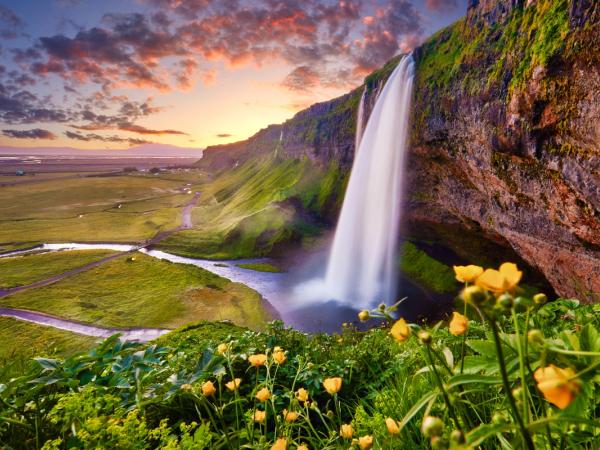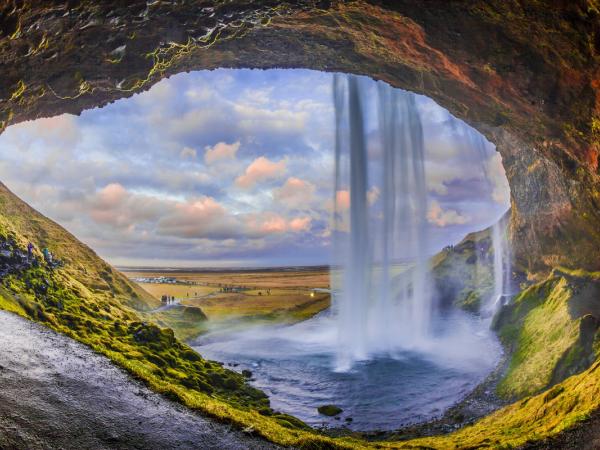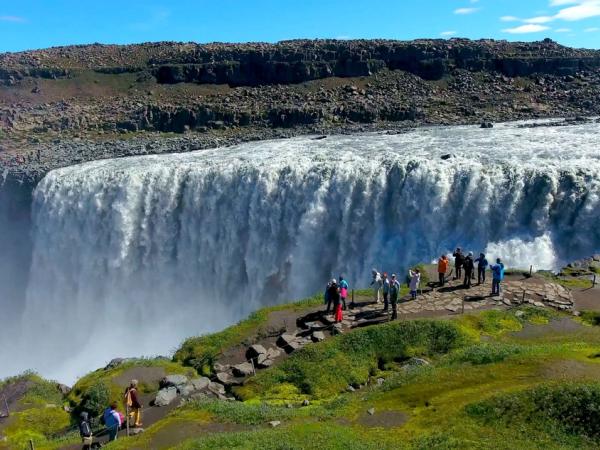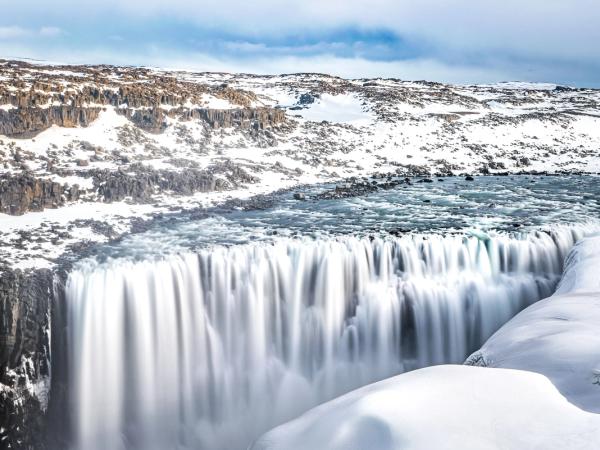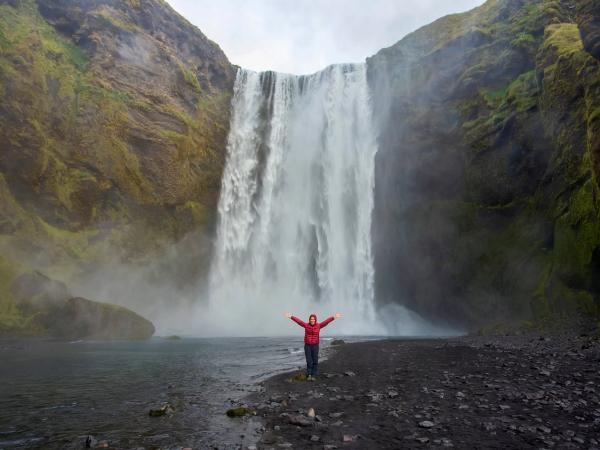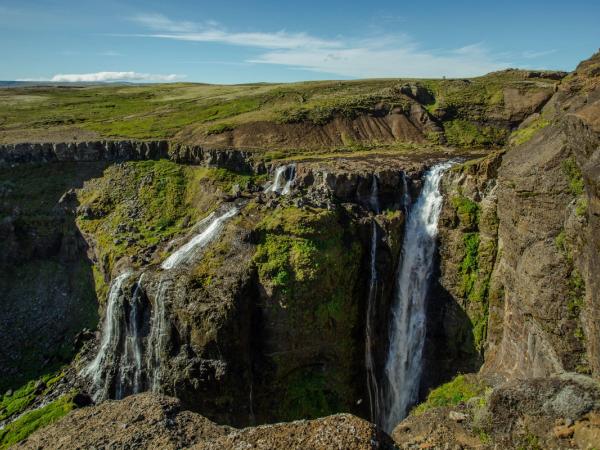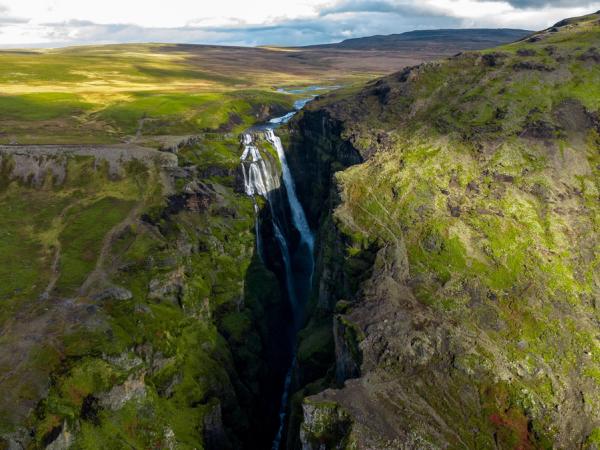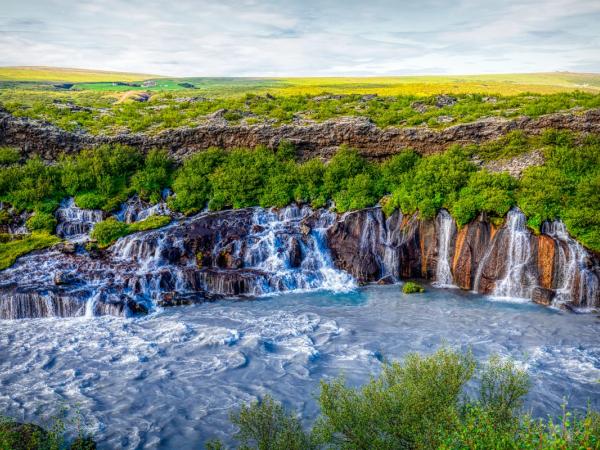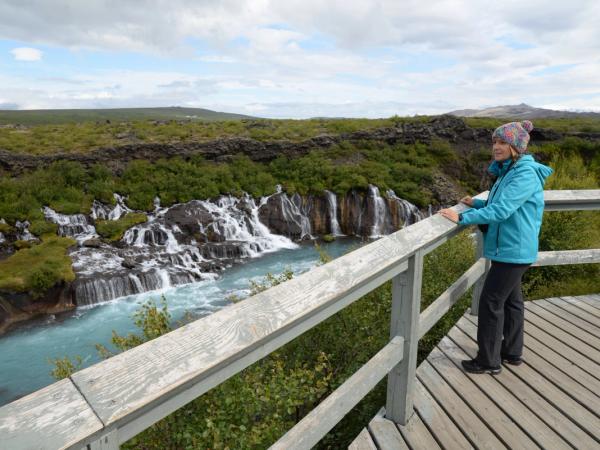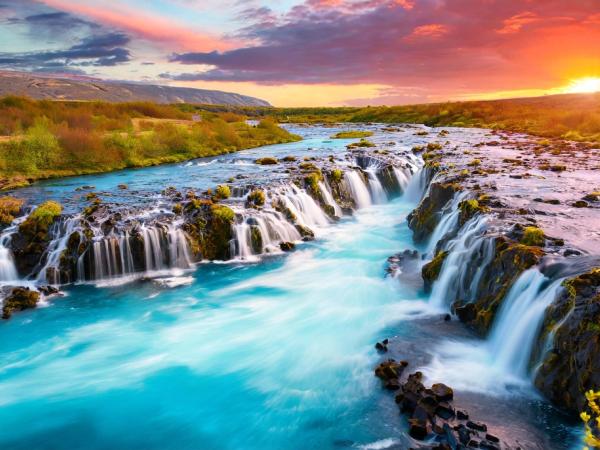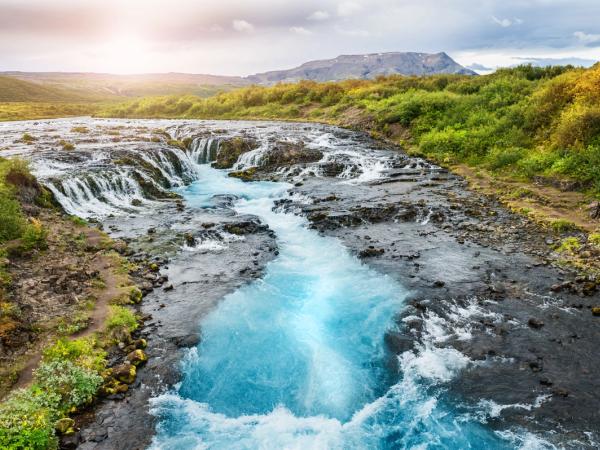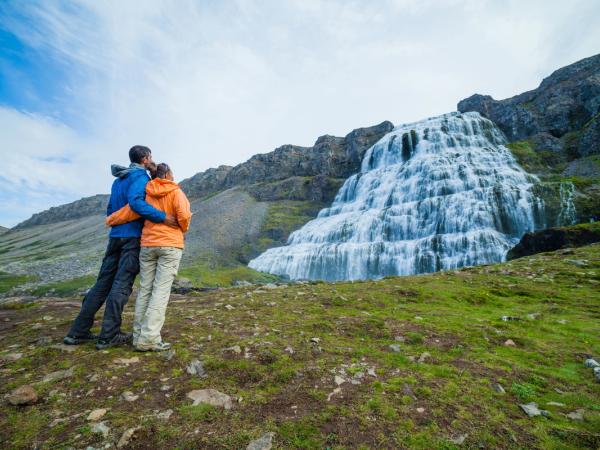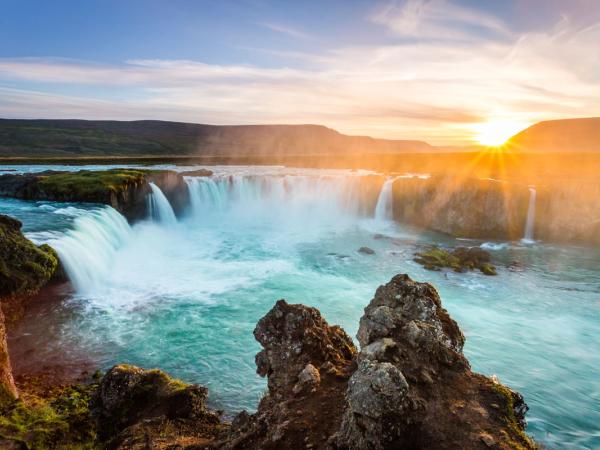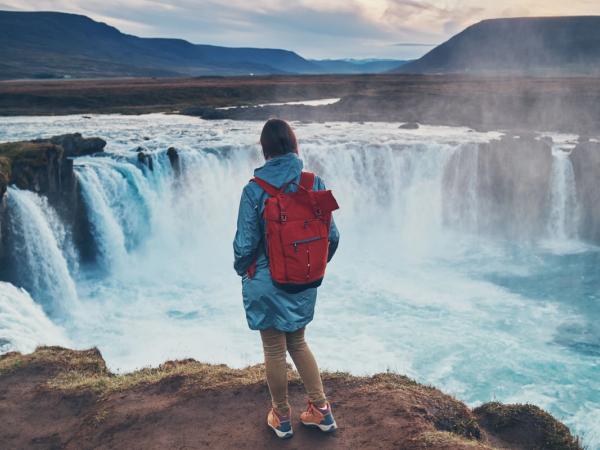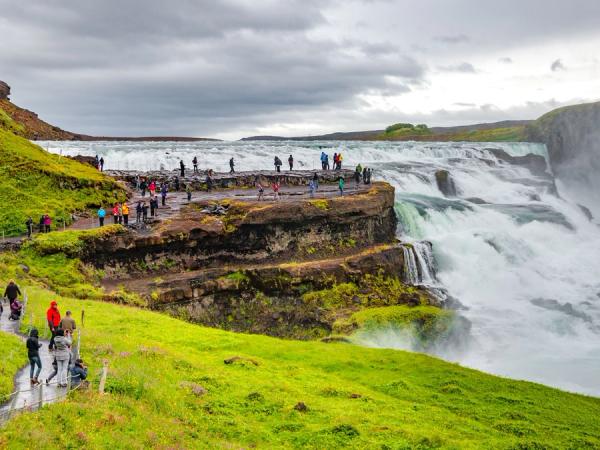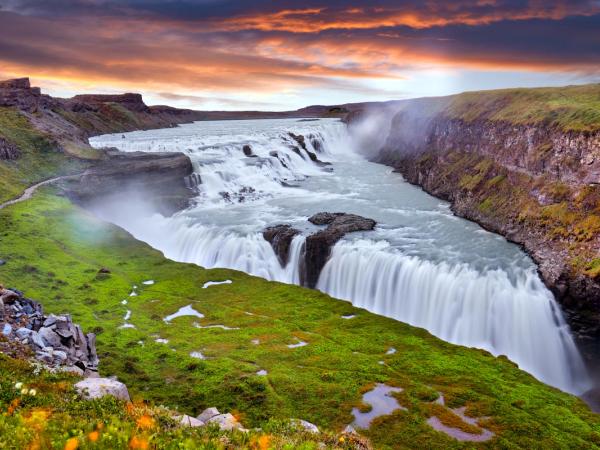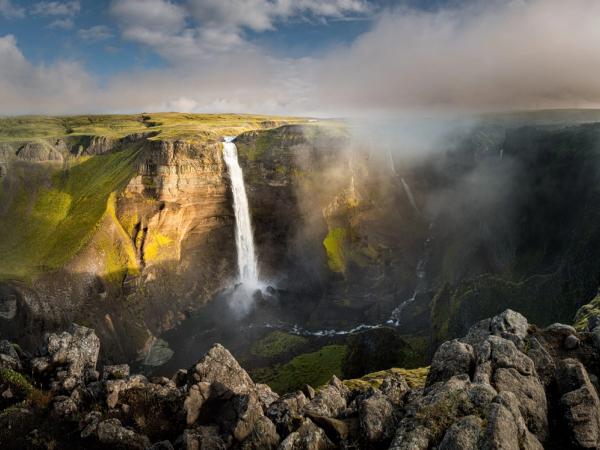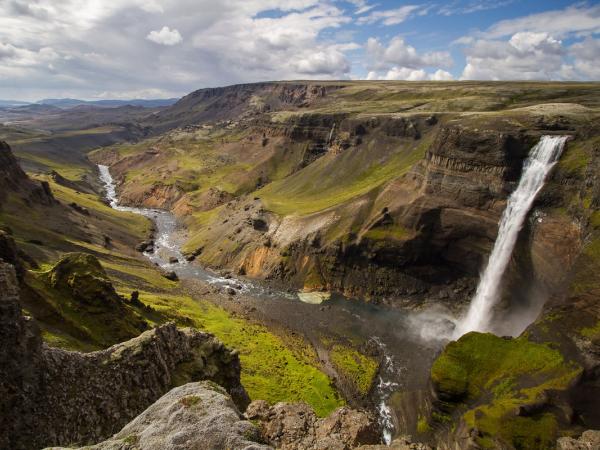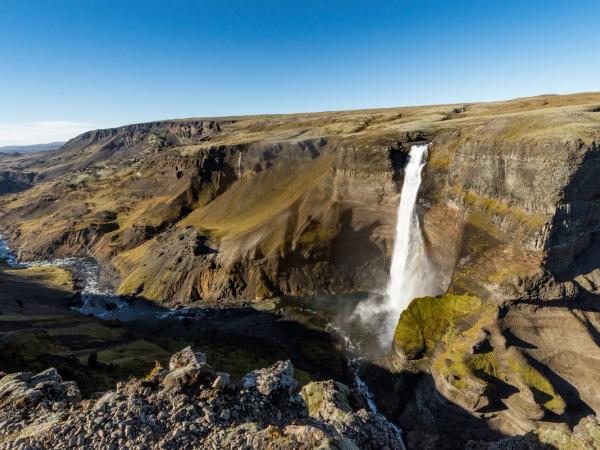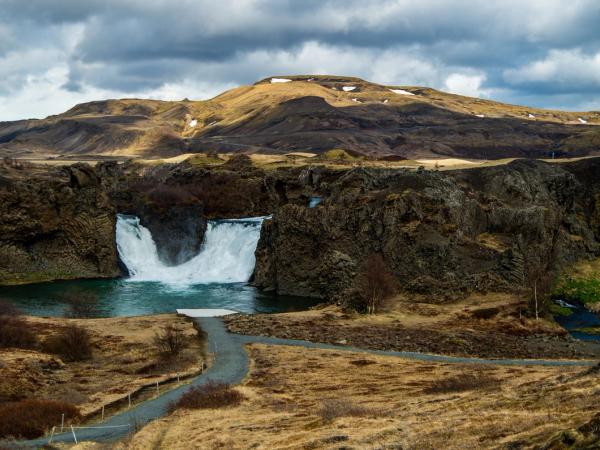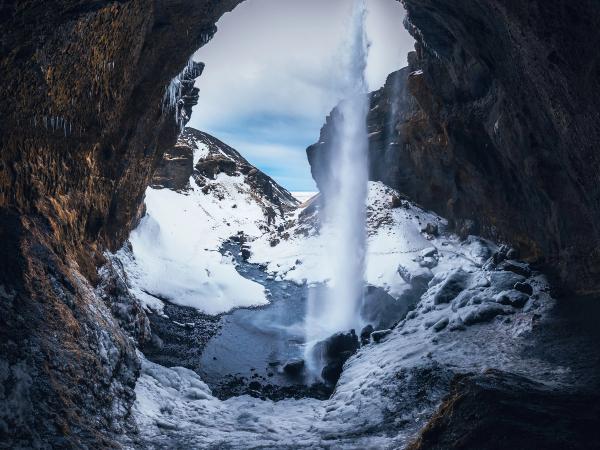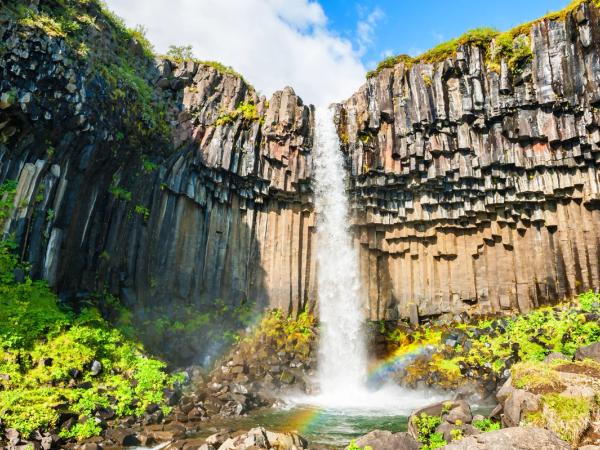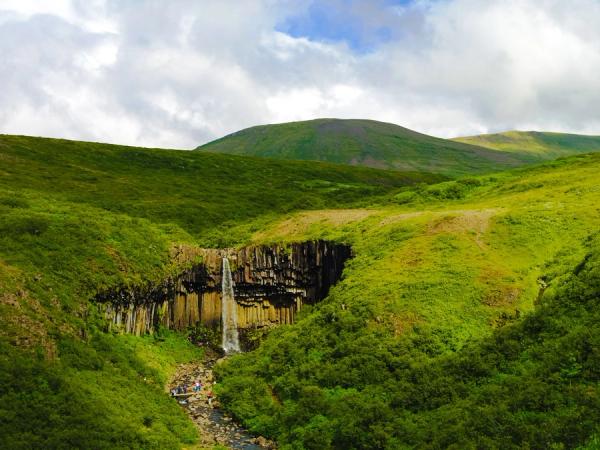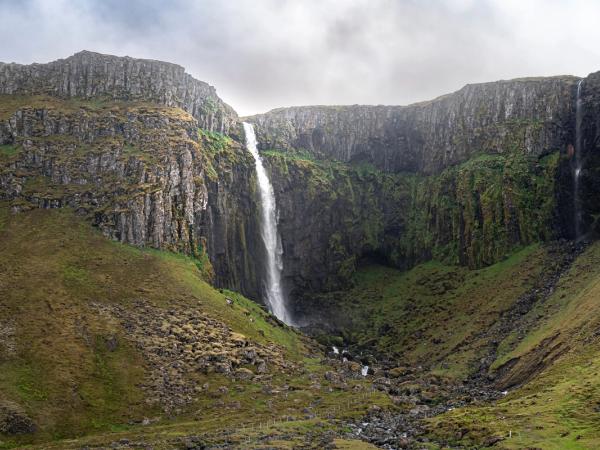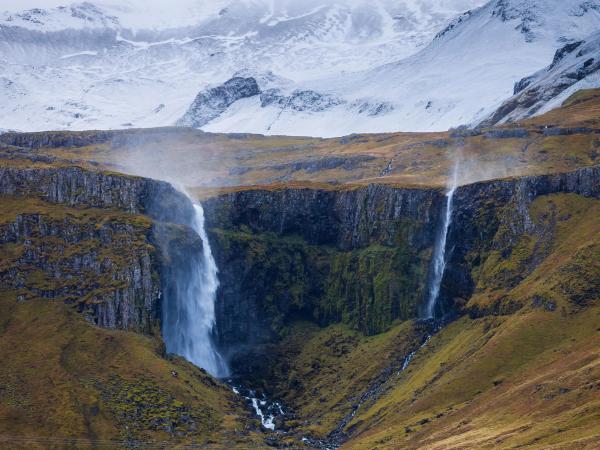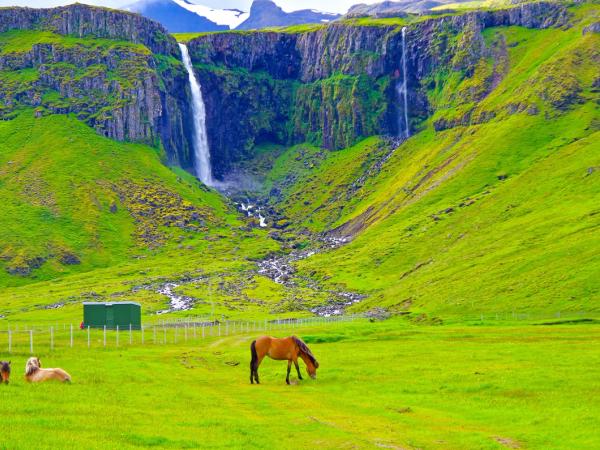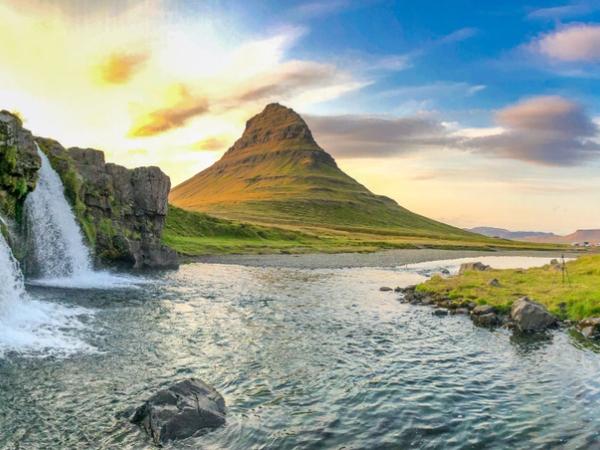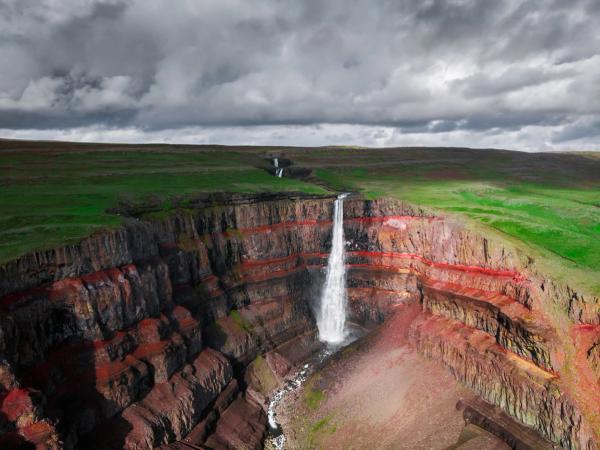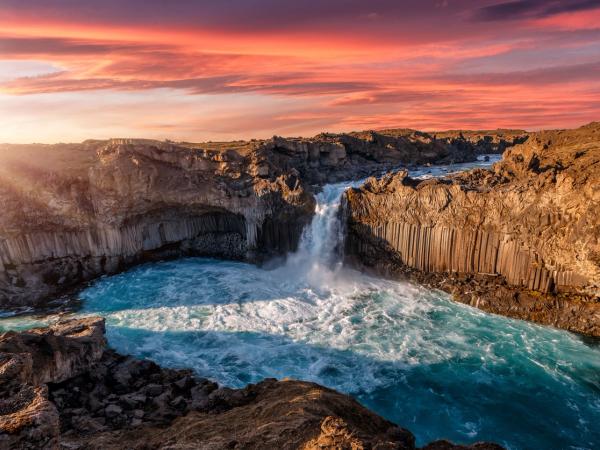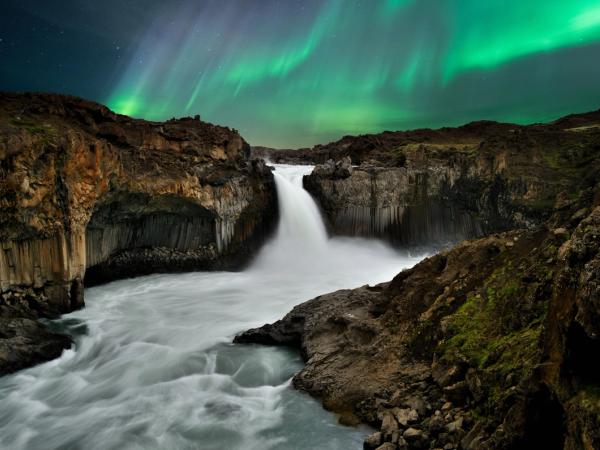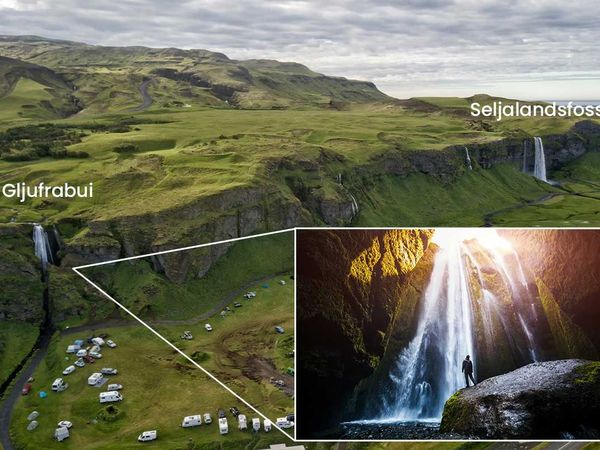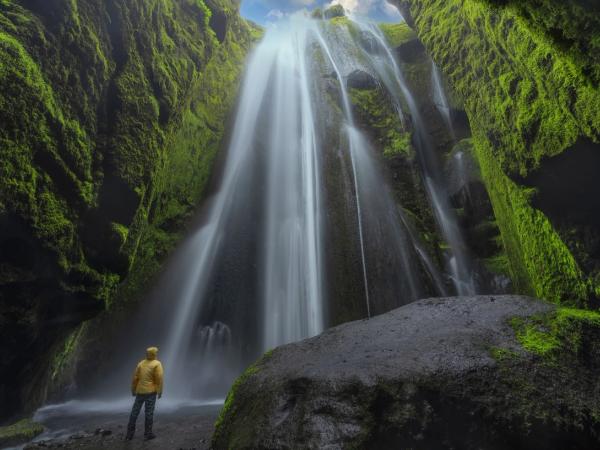
Top 23 Best Waterfalls to Visit in Iceland
Iceland is world-renowned for its bubbling volcanoes and pure glaciers, hence the nickname "Land of Fire and Ice." The two combine to form some of the largest and most gorgeous waterfalls humanity has ever seen. With over 10,000 waterfalls to explore, you have no excuse for not visiting at least one before you depart. Should you be at a loss for which ones are worth checking out, refer to this list of the top 23 best waterfalls in Iceland.
1. Seljalandsfoss
Waterfall in the South region of Iceland
Seljalandsfoss is a showstopper on Iceland's south coast, about a 2-hour drive from Reykjavík. What makes it special? You can walk behind it! The 60-meter (197-foot) drop creates a misty curtain of water, and the surrounding green cliffs make for stunning photos.
Here's a local tip: don't miss Gljúfrabúi, a hidden waterfall just a short walk from Seljalandsfoss. It's tucked away in a small canyon, adding a bit of adventure to your visit. Seeing these two waterfalls makes for a perfect day trip along the south coast.
2. Dettifoss Waterfall
Waterfall in Northeast Iceland
If you're after raw power, Dettifoss is your waterfall. It's the second most powerful in Europe, located in North Iceland. The trip from Reykjavík is long - about 6 hours - so it's probably better to plan your visit from Akureyri or Húsavik. Dettifoss is 100 meters (328 feet) wide and drops 45 meters (147.6 feet) with a thunderous roar. The mist can be seen from far away, building excitement as you approach. Dettifoss's western side was the 7th most-visited place in Iceland in 2024, with 236,738 visitors.
While you're there, check out Selfoss upstream. It's calmer but just as beautiful. And don't miss Ásbyrgi Canyon nearby - it's a lush, horseshoe-shaped wonder great for hiking. These spots together show off North Iceland's natural beauty.
3. Skógafoss Waterfall
Waterfall in the south of Iceland
Skógafoss is a classic. It's big, beautiful, and easy to get to - just a 2-hour drive from Reykjavík. The fall is 60 meters (197 feet) high and 25 meters (82 feet) wide, creating a massive wall of water. You can walk right up to it (but be ready to get wet!) or climb stairs to a viewing platform for a bird's-eye view.
After seeing the falls, visit the Skógar Museum next door. It's full of interesting information about Icelandic history and culture. If you're feeling adventurous, Skógafoss marks the start of the Fimmvörðuháls hike, a challenging but rewarding trek through some of Iceland's most stunning landscapes.
4. Glymur Waterfall
Waterfall in the west of Iceland
Glymur used to be Iceland's tallest waterfall until we discovered an even taller one recently (more on that later). It's about an hour's drive from Reykjavík, dropping 198 meters (650 feet) into a deep canyon. Getting to Glymur is an adventure in itself - you'll need to hike, cross a river, and even walk through a small cave.
The trail offers amazing views of Hvalfjörður (Whale Fjord) along the way. After your hike, take some time to explore the fjord. It's quieter than many tourist spots, with scenic viewpoints and even some World War II ruins that hint at Iceland's role in the war.
5. Hraunfossar
Waterfall in West Iceland
Hraunfossar is unlike any other waterfall you'll see in Iceland. Instead of one big drop, it's a series of streams flowing out of a lava field into the Hvítá River. It's about a 1.5-hour drive from Reykjavík and makes for a peaceful day trip.
Just a short walk from Hraunfossar, you'll find Barnafoss. It's a wilder waterfall with an interesting local legend attached to it - ask around when you visit; Icelanders love sharing these stories. While you're in the area, consider exploring Víðgelmir lava cave. It's one of Iceland's largest lava tubes and offers a fascinating look at the country's volcanic history.
6. Bruarfoss
Waterfall in the southwest of Iceland
Brúarfoss isn't the biggest waterfall you'll see in Iceland, but it might be the bluest. It's only about 3 meters (10 feet) tall, but the vivid blue water makes it a favorite for photographers. It's roughly an hour's drive from Reykjavík, but you'll need to hike a bit to reach it. The walk is worth it - it feels like you've stumbled upon a secret.
While you're there, check out Hlauptungufoss and Midfoss nearby. They're part of the same river system and less known, so you might have them all to yourself. It's a great way to spend a day if you want to avoid the busier tourist spots.
7. Dynjandi
Waterfall in the Westfjords region
Dynjandi is the crown jewel of the Westfjords. It's a bit of a trek from Reykjavík - about a 5-hour drive - so it's better to include it on your Westfjords itinerary. The waterfall cascades down in a series of steps, spreading out at the bottom like a bridal veil. It's 100 meters (328 feet) tall and truly spectacular.
While you're in the Westfjords, take time to explore the area. It's one of the most remote parts of Iceland, with dramatic landscapes, quiet fishing villages, and some of the best bird-watching in the country. If you're looking to get off the beaten path, this is the place to do it.
Personally, Dynjandi Falls is one of my favorites to visit.
8. Goðafoss Waterfall
Goðafoss is located in the northeast part of Iceland.
Goðafoss, or "Waterfall of the Gods," is steeped in Icelandic history. Legend has it that when Iceland converted to Christianity around 1000 AD, a local chieftain tossed his pagan god statues into the falls. Whether you believe the story or not, the waterfall is impressive - 12 meters (39 feet) high and 30 meters (98 feet) wide, with a unique horseshoe shape. Government data shows that Goðafoss eastern side was the 6th most-visited place in 2024, with 288,430 visitors.
After seeing Goðafoss, head to nearby Lake Mývatn. It's known for its unique landscapes, bird life, and the Mývatn Nature Baths - a great place to relax after a day of exploring. It's like a quieter, more local version of the Blue Lagoon.
9. Gullfoss Waterfall
Located in Southwest Iceland
No list of Icelandic waterfalls would be complete without Gullfoss. It's part of the Golden Circle, Iceland's most popular tourist route, for good reason. Its beauty and convenient location made Gullfoss the most visited spot in Iceland in 2024, with over 1.5 million visitors.
The waterfall drops in two stages into a rugged canyon, creating a powerful display that's impressive year-round. In sunlight, the mist often creates rainbows - hence the name "Golden Falls."
Gullfoss is an easy day trip from Reykjavík, often combined with visits to Geysir (where you can see geysers erupt) and Þingvellir National Park (where you can walk between tectonic plates). It's a great introduction to Iceland's diverse landscapes.
10. Morsárfoss
Located in Southeast Iceland
Here's a bit of trivia: Morsárfoss is Iceland's tallest waterfall, but we only discovered it recently when the Morsárjökull glacier started to melt. At 228 meters (748 feet) tall, it's an impressive sight, but it's not easy to get to. You'll need a guided hike to reach it, making it a great option if you're looking for a challenge off the typical tourist path.
Morsárfoss is in Vatnajökull National Park, home to Europe's largest glacier. While you're there, consider a glacier walk, an ice cave tour, or a boat trip on a glacial lagoon. It's a stark, beautiful landscape that really shows the power of nature.
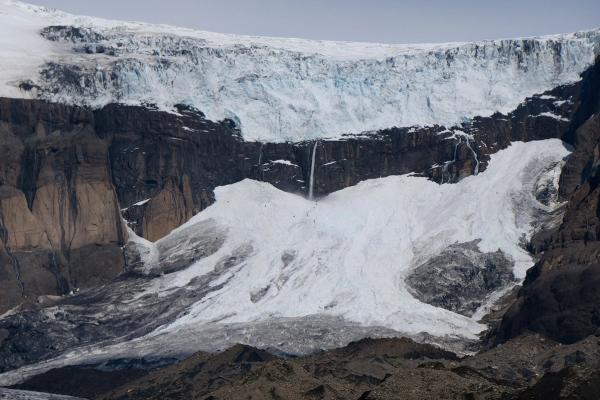
11. Háifoss
Waterfall in South Iceland
At 122 meters (400 feet), Háifoss is one of Iceland's highest waterfalls. It's about a 2.5-hour drive from Reykjavík in the Þjórsárdalur valley. The waterfall plunges into a deep, rugged canyon, creating a scene that looks like it's straight out of "Lord of the Rings."
Near Háifoss, you'll find Granni waterfall - its name literally means "neighbor." The two falls side by side make for a great photo op. If you're into volcanoes, consider a trip to nearby Hekla. It's one of Iceland's most active volcanoes and has some great hiking trails.
12. Granni
Waterfall in South Iceland
We just mentioned Granni, but it deserves its own spotlight. While it's not as tall as its neighbor Háifoss, Granni has its own charm. The drive to reach these falls takes you through some of Iceland's most dramatic highland scenery.
After seeing the falls, explore more of Þjórsárdalur valley. It's a beautiful mix of green fields, rivers, and volcanic landscapes. Don't miss Þjóðveldisbærinn, a reconstructed Viking-era farm. It's a fascinating glimpse into how early Icelanders lived.
13. Hjálparfoss
Waterfall in South Iceland
Hjálparfoss is a hidden gem in Þjórsárdalur valley. It's actually two falls side by side, joining at the base in a tranquil pool. The surrounding basalt formations add to its unique look. It's a great spot for a picnic and less crowded than many of Iceland's more famous falls.
While you're in the area, check out Gjáin, a small valley that looks like something out of a fairy tale. It's filled with small waterfalls, lush vegetation, and interesting rock formations. It's a photographer's dream, especially in the soft light of the midnight sun.
14. Kvernufoss
Waterfall in South Iceland
If you like the idea of walking behind a waterfall but want to avoid the crowds at Seljalandsfoss, Kvernufoss is your spot. It's just a short hike from the popular Skógafoss, but many visitors miss it. The 30-meter (98-foot) fall cascades in front of a small cave, letting you walk behind the water for a unique view.
Combine your visit to Kvernufoss with a stop at the nearby Skógar Museum. It's one of the best folk museums in Iceland, with exhibitions on how Icelanders lived in centuries past. The turf houses are particularly interesting.
15. Selfoss
Waterfall in South Iceland
Not to be confused with the town of the same name, Selfoss Waterfall is the often-overlooked neighbor of the mighty Dettifoss. While not as powerful, many visitors find Selfoss more beautiful, with its wide horseshoe shape. It's a short walk upstream from Dettifoss, and the two falls make for a great contrast.
After visiting the falls, take a drive to nearby Ásbyrgi, a horseshoe-shaped canyon that, according to legend, was formed by the hoofprint of Odin's eight-legged horse. It's a lush oasis in the otherwise stark northern landscape.
16. Svartifoss
Waterfall located in Southeast Iceland
Svartifoss, or "Black Falls," is one of Iceland's most distinctive waterfalls. It's framed by dark basalt columns that look almost man-made. These columns have inspired a lot of Icelandic architecture, including Hallgrímskirkja church in Reykjavík.
Svartifoss is in Skaftafell, part of Vatnajökull National Park. The hike to the falls is fairly easy and offers great views along the way. While you're there, take some time to explore the park - there are trails leading to glaciers, other waterfalls, and stunning viewpoints.
17. Grundarfoss
Waterfall located in West Iceland
Grundarfoss is a bit of a hidden gem on the Snæfellsnes Peninsula. It's often overlooked in favor of the more famous Kirkjufellsfoss, but it's well worth a visit. The 70-meter (230-foot) falls cascade down a steep cliff, creating a dramatic scene.
While you're on Snæfellsnes, make sure to check out Kirkjufellsfoss and Kirkjufell Mountain - it's one of Iceland's most photographed spots. The peninsula is often called "Iceland in miniature" because it packs so many different landscapes into a small area.
18. Kirkjufellsfoss
Waterfall located in the Westfjords
If you've seen photos of Iceland, you've probably seen Kirkjufellsfoss. This waterfall is famous because of the mountain behind it, Kirkjufell, which looks like a church steeple. It's on the Snæfellsnes Peninsula, about a 2.5-hour drive from Reykjavík. The waterfall isn't very big, but it's split into three parts, which makes it look really cool.
While you're there, check out the Snæfellsjökull glacier nearby. It's the same glacier that Jules Verne wrote about in his book "Journey to the Center of the Earth." You can also visit some neat places close by, like Arnarstapi with its rocky cliffs, and Djúpalónssandur, a beach with black sand. If you come in winter, you might even see the Northern Lights!
19. Hengifoss
Waterfall located in East Iceland
Hengifoss is one of the highest waterfalls in Iceland at 128 meters (420 feet). What makes it unique is the red clay and basalt layers in the cliff behind the falls. It creates a striking striped pattern that looks almost painted on.
The hike to Hengifoss takes about an hour each way, but it's worth the effort. On the way, you'll pass another beautiful waterfall, Litlanesfoss, which is framed by basalt columns. After your hike, take a drive around Lagarfljót lake and keep an eye out for the legendary Lagarfljót Worm - Iceland's version of the Loch Ness Monster!
20. Aldeyjarfoss
Waterfall located in North Iceland
Last but definitely not least, Aldeyjarfoss is a stunning waterfall in North Iceland. It's known for the contrast between the white water and the dark basalt columns surrounding it. The geometric shapes of the basalt create a scene that almost looks unreal.
Aldeyjarfoss is a bit off the beaten path, which means you might have it all to yourself. It's a great starting point for exploring Iceland's highlands - some of the country's most remote and dramatic landscapes. If you're up for more waterfall hunting, nearby Hrafnabjargafoss is another hidden gem.
21. Bjarnarfoss
Waterfall located in the Snæfellsnes Peninsula
Bjarnarfoss is a waterfall on the Snæfellsnes Peninsula, with water dropping about 80 meters (262 feet) down a rocky cliff. The waterfall flows from the Bjarnarhafnarfjall mountain, and on sunny days, you can sometimes see rainbows in the mist. A path leads to the base of the falls, where you can get close to the water and enjoy views of the surrounding fields and coastline.
The waterfall is easy to reach, located right off Route 54 and about a 10-minute drive from Búðir and its famous black church. The Snæfellsnes Peninsula has many other places to visit, like Arnarstapi and Lóndrangar, so you can easily add Bjarnarfoss to your itinerary. It’s usually less crowded than other waterfalls, so it's a nice place to avoid the crowds and take some cool pictures.
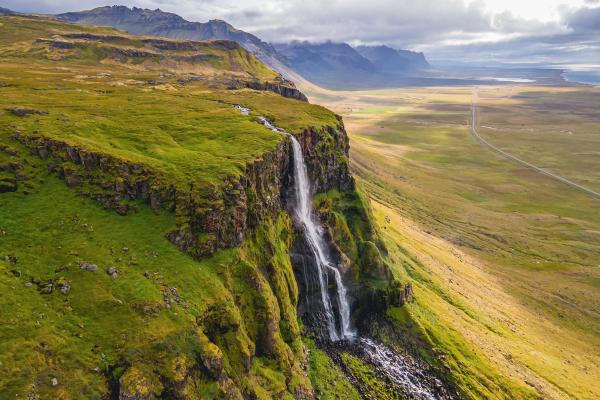
22. Gljúfrabúi
Waterfall located in South Iceland
Gljúfrabúi is a waterfall near Seljalandsfoss on Iceland’s South Coast. It’s partly hidden behind a cliff, so you must walk through a narrow opening and wade through a shallow stream to see it. Wear waterproof shoes, as there's a 100% chance you'll wet your socks and feet otherwise. Inside, you’ll find a 40-meter (131-foot) waterfall surrounded by moss-covered rocks, creating a quiet, enclosed spot.
The waterfall is just off the Ring Road, about a 2-hour drive from Reykjavík. Since most people visit Seljalandsfoss, Gljúfrabúi is often less crowded. A short path connects the two, so you can easily visit both. It takes literally 10 minutes to get from one waterfall to the other. Other nearby spots like Skógafoss and the black sand beaches near Vík are also worth checking out.
23. Öxarárfoss
Öxarárfoss sits in Þingvellir National Park on Iceland's Golden Circle route, 40 kilometers from Reykjavík. This 13-meter waterfall has a cool backstory – Vikings made it in the 10th century by changing the river's path to bring water to the old parliament. The waterfall looks different based on when you go – green in summer and frozen in winter. It's easy to reach with a 30-minute walk from where you park, so most people can visit without problems.
While there, see the nearby Silfra Fissure where you can swim between two continents, or check out the old Althing meeting place. TV fans might know it as the "Bloody Gate" from Game of Thrones, and some music fans spot it on a Nine Inch Nails album. Parking costs 1000 ISK (about $7.35).

Final Thoughts
Who knew such a small island like Iceland could boast of such endless amounts of natural wonders?
These are just twenty two of the thousands of waterfalls you’ll find here.
For more ideas on what to do in Iceland, be sure to check out the 10 best things to do in Iceland, or if you need help planning your trip in Iceland, contact us, and we will help you out.
I hope you enjoy your trip to Iceland!

